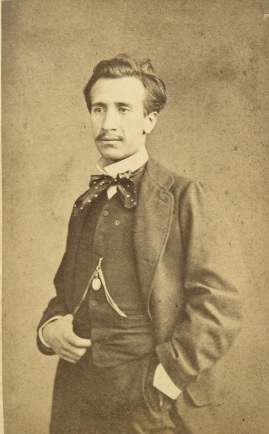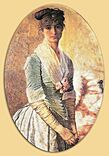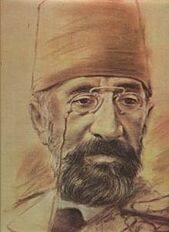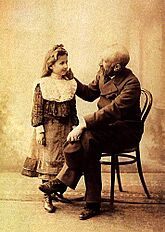Osman Hamdi Bey facts for kids
Quick facts for kids
Osman Hamdi Bey
|
|
|---|---|
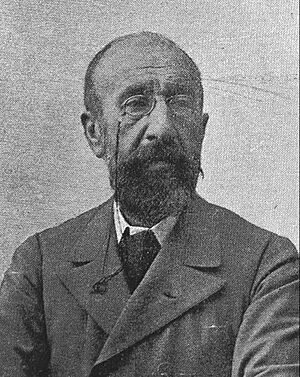
Osman Hamdi in 1909
|
|
| Born |
Osman Hamdi
30 December 1842 Constantinople (Istanbul), Ottoman Empire
|
| Died | 24 February 1910 (aged 67) Constantinople, Ottoman Empire
|
| Known for | Painter, archaeologist, museographer and writer |
|
Notable work
|
The Tortoise Trainer |
Osman Hamdi Bey (born December 30, 1842 – died February 24, 1910) was a very important person in the Ottoman Empire. He was a smart leader, an art expert, and a talented painter. He was the first modern archaeologist in the Ottoman Empire. He is known as the founder of archaeology and the job of a museum curator in Turkey.
Osman Hamdi Bey started the Istanbul Archaeology Museums and the Istanbul Academy of Fine Arts. This art school is now called the Mimar Sinan Fine Arts University. He was also the first mayor of Kadıköy, a district in Istanbul.
Contents
Osman Hamdi Bey's Early Life
Osman Hamdi was the son of Ibrahim Edhem Pasha. His father was a Grand Vizier, which was like a prime minister in the Ottoman Empire. Ibrahim Edhem Pasha was originally a Greek boy from the island of Chios. He became an orphan after a terrible event called the Chios massacre. He was adopted by a powerful admiral, Hüsrev Pasha, and grew up to be part of the ruling class.
Osman Hamdi went to primary school in Beşiktaş, a popular area in Istanbul. After that, he studied law in Istanbul starting in 1856, and then in Paris in 1860. But he loved painting more than law. So, he left his law studies to learn painting. He trained with famous French painters Jean-Léon Gérôme and Gustave Boulanger. He lived in Paris for nine years, which was a major center for art at the time. He was very interested in all the art events happening there.
During his time in Paris, the Ottoman Sultan Abdülaziz visited Western Europe for the first time. He was invited to a big exhibition in Paris in 1867. Osman Hamdi Bey also met many young Ottoman thinkers in Paris. Even though he learned about their new ideas, he didn't join their political groups. His father was loyal to the sultan and the old system of rule.
While in Paris, Osman Hamdi Bey met his first wife, Marie, who was French. With his father's permission, she came back to Istanbul with him in 1869. They got married and had two daughters.
When he returned to Turkey, he worked in the government in the Ottoman province of Baghdad. In 1871, he came back to Istanbul and worked in the Palace's Protocol Office. In the 1870s, he had several important jobs in the Ottoman government. He became the first mayor of Kadıköy in 1875 and held that position for one year.
His Amazing Career in Art and History
Osman Hamdi showed three of his paintings at the 1867 Paris Exposition Universelle. Sadly, these paintings are not known to exist today.
A very important step in his career was becoming the director of the Imperial Museum (Müze-i Hümayun) in 1881. He used this job to improve the museum. He also wrote new laws to protect old artifacts and started archaeological digs supported by the government. Osman Hamdi worked to build connections with museums and universities around the world, like the University of Pennsylvania.
In 1882, he started the Academy of Fine Arts and became its director. This school allowed Ottoman students to learn about art and art techniques without leaving the empire. In 1884, he helped create a rule that stopped historical items from being secretly taken out of the country. This was a huge step in protecting ancient treasures. Before this, people from European countries often smuggled valuable artifacts out of the Ottoman Empire to fill museums in Europe.
He led the first scientific archaeological research done by a Turkish team. His excavations included places like the ancient tomb-sanctuary in Nemrut Dağı in southeastern Anatolia. This site is now a famous tourist spot and a UNESCO World Heritage Site. He also dug at the Hekate sanctuary in Lagina and in Sidon in Lebanon.
The ancient stone coffins, called sarcophagi, he found in Sidon are considered some of the most amazing archaeological discoveries in the world. One of them is known as the Alexander Sarcophagus. To house these treasures, he began building what is now the Istanbul Archaeology Museum in 1881. The museum officially opened in 1891 with him as its director.
Throughout his career as a museum and art academy director, Osman Hamdi continued to paint. He often painted himself and his family in his artworks.
-
Self-portrait, Osman Hamdi Bey Museum, Gebze
-
Osman Hamdi Bey excavating at the archaeological site in Mount Nemrut
-
Osman Hamdi Bey with his daughter Nazlı. Osman Hamdi Bey Museum, Gebze.
The Famous Painting: The Tortoise Trainer

Osman Hamdi Bey's painting, The Tortoise Trainer, from 1906, was the most valuable Turkish painting for many years. It was sold for about 3.5 million US dollars in 2004. The Pera Museum in Istanbul bought it.
The painting shows Osman Hamdi Bey himself, dressed in old-fashioned clothes, training tortoises inside a mosque. Many people think this painting is a comment on Turkey's changing identity. It might also be a funny way for the painter to show his own style compared to others. It also refers to a historical event from the early 1700s, when tortoises were sometimes used to carry candles for light during evening parties. The painting is now at the Pera Museum in Istanbul.
Another one of his paintings, Girl Reciting Qur'an (1880), broke a new record in 2019, selling for 7.8 million US dollars.
Experts have identified the tortoises in the painting as a type of Spur-thighed tortoise. A picture of the painting even appeared on the cover of a science magazine about reptiles.
A historian named Edhem Eldem found that the idea for the painting might have come from a picture of a Korean circus performer in a French travel magazine from 1869. The exact meaning of the tortoises in the painting is still discussed by scholars.
His Artistic Style and Other Works
Osman Hamdi Bey was a very active painter and writer. His work often explored themes of archaeology, travel, and local customs in the Middle East.
He learned painting in Paris from Gustave Boulanger and Jean-Léon Gérôme. These artists were part of the French Orientalist school, which often painted scenes from the Middle East. Even though he learned from them, Osman Hamdi Bey painted Ottoman people differently. He showed them as more active and thoughtful. Because he was an Ottoman intellectual, many people see his use of Orientalist styles as a way to challenge or criticize European Orientalism. During his lifetime, his paintings were shown more often in Europe than in Turkey.
From 1880 onwards, he showed his art in Paris, Vienna, Berlin, Munich, and London. He also started an art gathering in Constantinople. His paintings show his careful and detailed work. They are also important historical documents about art. He was the first Turkish artist to break away from traditional Turkish painting styles.
Some of his famous paintings include Prophet's Tomb at Brussa, Miraculous Springs, Reading the Coran (1890), and Theologian.
You can find his paintings in private collections and museums in Vienna, Paris, Liverpool, New York, Berlin, and Istanbul.
Famous Paintings
Paintings at the Pera Museum, Istanbul
-
Külliye of Çoban Mustafa Pasha in Gebze (1880s)
Paintings at Museums Outside Turkey
-
Persian carpet dealer on the street (1888), Alte Nationalgalerie, Berlin
-
Man in front of children's tombs in a türbe (1903), Musée d'Orsay, Paris
Osman Hamdi Bey's Family

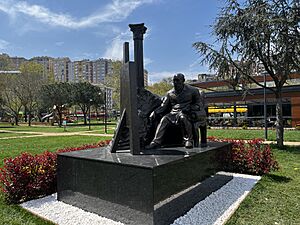
- His daughter Nazlı Hamdi (1893–1958) married an Ottoman diplomat.
- He was the brother of Halil Edhem Eldem, who became the Director of the Istanbul Archaeology Museums after Osman Hamdi Bey's death.
- He was also the brother of İsmail Galib Bey, who is known as the founder of the scientific study of coins (numismatics) in Turkey.
- He was the great-uncle of Sedad Hakkı Eldem, a famous Turkish architect.
- He was also the great-uncle of Cemal Reşit Rey, one of the five pioneers of classical music in Turkey.
Documentary Films About Osman Hamdi Bey
- Osman Hamdi Bey: Kaplumbağa Terbiyecisi ("Osman Hamdi Bey: The Tortoise Trainer") is a 2012 documentary film about his life and works.
See Also
- List of Orientalist artists
- Pascal Sébah
Images for kids


